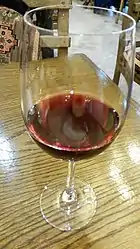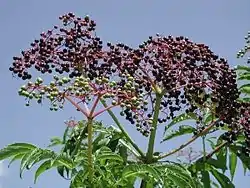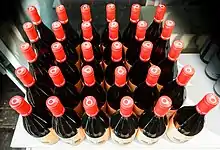Fruit wine
Fruit wines are fermented alcoholic beverages made from a variety of base ingredients (other than grapes); they may also have additional flavors taken from fruits, flowers, and herbs. This definition is sometimes broadened to include any fermented alcoholic beverage except beer. For historical reasons, mead, cider, and perry are also excluded from the definition of fruit wine.[1][2]

Fruit wines have traditionally been popular with home winemakers and in areas with cool climates such as North America and Scandinavia; in East Africa, India, and the Philippines, wine is made from bananas.
Labeling
Fruit wines are usually referred to by their main ingredient (e.g., plum wine or elderberry wine) because the usual definition of wine states that it is made from fermented grape juice.
In the European Union, wine is legally defined as the fermented juice of grapes.[3]
In the United Kingdom, fruit wine is commonly called country wine; the term should not be conflated with the French term vin de pays, which is grape wine. In British legislation, the term made-wine is used.[4]
Production

Fruit wine can be made from virtually any plant matter that can be fermented.[3] Most fruits and berries have the potential to produce wine. There are a number of methods of extracting flavour and juice from the fruits or plants being used; pressing the juice, stewing and fermenting the pulp of the fruits are common.[5] Few foods other than grapes have the balanced quantities of sugar, acid, tannin, nutritive salts for yeast feeding, and water to naturally produce a stable, drinkable wine, so most country wines are adjusted in one or more respects at fermentation. However, some of these products do require the addition of sugar or honey to make them palatable and to increase the alcoholic content (sugar is converted to alcohol in the fermentation). Two commonly produced varieties are elderberry wine and dandelion wine. Tainted elderberry wine is the beverage used to commit murders in Joseph Kesselring's play and Frank Capra's film adaptation Arsenic and Old Lace. A wine made from elderberry flowers is called elder blow wine.
The amount of fermentable sugars is often low and needs to be supplemented by a process called chaptalization in order to have sufficient alcohol levels in the finished wine. Sucrose is often added so that there is sufficient sugar to ferment to completion while keeping the level of acidity acceptable. If the specific gravity of the initial solution is too high, indicating an excess of sugar, water or acidulated water may be added to adjust the specific gravity down to the winemaker's target range.
Many kinds of fruit have a natural acid content which would be too high to produce a savory and pleasant fruit wine in undiluted form; this can be particularly true, among others, for strawberries, cherries, pineapples, and raspberries. Therefore, much as to regulate sugar content, the fruit mash is generally topped up with water prior to fermentation to reduce the acidity to pleasant levels. This also dilutes and reduces overall fruit flavor; a loss of flavor can be compensated for by adding sugar again after fermentation which then acts as a flavor enhancer (known as a back-sweetener), while too much acid in the finished wine will always give it undesired harshness and pungency.
Many fruit wines suffer from a lack of natural yeast nutrients needed to promote or maintain fermentation. Winemakers can counter this with the addition of nitrogen, phosphorus and potassium available commercially as yeast nutrient. In the opinion of one wine writer fruit wines often do not improve with bottle age and are usually meant to be consumed within a year of bottling.[6]
Plum liquor
_2.jpg.webp)
Plum liquor is popular in East Asian countries of Japan, Korea and China.
In China, plum liquor is called Meijiu (梅酒). Plum wine is normally made with baijiu (白酒; clear liquor) and soaked with plum. The alcohol level is higher than typical fruit wine, which is just fermented with fruits.
Umeshu (梅酒) is a Japanese alcoholic drink made by steeping green plums in shōchū (燒酎; clear liquor). It is sweet and smooth.
A similar liquor in Korea, called maesil-ju (매실주), is marketed under various brand names, including Mae hwa soo, Matchsoon, and Seoljungmae. Both the Japanese and Korean varieties of plum liquor are available with whole Prunus mume fruits contained in the bottle.
In Taiwan, a popular post-World War II innovation based on Japanese-style plum liquor is wumeijiu (烏梅酒; smoked plum liquor), which is made by mixing Prunus mume liquor (梅酒 méijǐu), Prunus salicina liquor (李酒 lǐjǐu), and oolong tea liquor.
Plum wine
Plum jerkum is made from fermented plums in a manner similar to the use of apples for cider. It was often associated with the north Cotswolds[7] and was once a product of the city of Worcester.[8]
Pomegranate wine

Pomegranate wine is a type fruit wine. A commercial pomegranate wine product was developed in Israel, and its marketed abroad as Rimon.
Pineapple wine

Pineapple wine is made from the juice of pineapples. Fermentation of the pineapple juice takes place in temperature-controlled vats and is stopped at near-dryness. The result is a soft, dry, fruit wine with a strong pineapple bouquet. Pineapple wine is popular in Thailand and other SE Asian countries, where it is made using traditional practices and is not available commercially.[9] In Mexico, fermented pineapple beverages are very popular and given the name Tepache.
Commercial examples from around the world include Maui's Winery in Hawaii and Jacobs Wines of Nigeria, the first pineapple winery in Africa. It is also made in Dominican Republic by Vinicola Del Norte, its alcohol content is 10%. Several varieties of pineapple wine are made in Okinawa, Japan, from local produce. Its alcohol content is 11.5% ABV.
Dandelion wine
Dandelion wine is a fruit wine of moderate alcohol content that is made from dandelion petals and sugar, usually combined with an acid (such as lemon juice).
While commonly made as a homemade recipe, there are a handful of wineries that commercially produce Dandelion wine, including Bellview Winery of New Jersey,[10] Breitenbach Winery of Ohio,[11] Hidden Legend Winery of Montana[12] and Maple River Winery of North Dakota.[13]
Rose hip wine
Rose hip wine is a fruit wine.[14] It can be made from fresh or dried rose hips. To produce this beverage, the rose hips are fermented in syrup with yeast and citric acid, creating an extract. This technique is used with only a few other types of fruit wine, including blackthorn (sloe), hawthorn, and rowan.
The best kind of wine produced from rose hips is strong and sweet, with at least two years of storage.[15]
Redcurrant and whitecurrant wines
Redcurrant and whitecurrant fruit wines are beverages that are usually produced in northerly cool areas, where it is hard to grow high-quality grapes. They are simple to produce. Their natural chemical balances are such that they can be self-clarified without any additional substances. Redcurrants and whitecurrants contain only a small amount of carbohydrates; this necessitates the addition of sugar or honey.[15]
Cherry wine
Cherry wine is a type of fruit wine made with cherries,[16][17][18][19] usually tart cherries that provide sufficient acid.[20] Cherry wines can be used to make fortified wines and liqueurs. Michigan wine makers, located in the leading tart-cherry-producing region of the United States, produce several varieties of cherry wine, including spiced versions and cherry-grape blends.[21] "Cherry Kijafa" is a fortified fruit wine that is produced in Denmark from cherries with added natural flavors, and usually contains 16% alcohol by volume.[22] Among cherry liqueurs Maraska, a cherry wine made from Marasca cherry from Croatia, is among the best known.[23] The last couple of years Fredriksdal Cherry Wine (partly invented by distinguished restaurant owner Jan Friis-Mikkelsen) has been produced in Denmark.[24] Cherry wine production is becoming popular in China,[25] where cherry production is high.[26]
Orange wine
Fruit wine can be made from oranges. This should not be confused with orange wine, also known as amber wine, which is made from grapes, but is orange/amber in color. Wine made from oranges, although not commercially widely available, is produced in White River, South Africa, and by home wine makers. The taste is a light bodied wine, pale or golden in color, dry, thin in body, alcoholic. Outcome is reliant on the yeast used. Recipes are few and far between.[27] Typically a home wine maker is receiving the bounty of their own orange tree or from a neighbors tree. The wine can be difficult to make because the fruit is very acidic, and the pH must be adjusted up. Further complications are encountered by a type of Penicillium mold that can stop the fermentation and spoil the wine. Great care must be taken to clean and sanitize the fruit. The remainder of the process is straightforward. The US government Alcohol and Tobacco Tax and Trade Bureau has a standard for orange wine.[28]
Other fruit wines
- Fruit wine made from Cranberries is called Cranes.
- Banana wine
- Lychee wine
- Fruit wine can also be made from Blackberry, Blackcurrant, Blueberry, Cranberry, Elderberry, Gooseberry, Mulberry, Seaberry, or Raspberry.
See also
References
- J. Robinson (ed) "The Oxford Companion to Wine" Third Edition pg 768 Oxford University Press 2006 ISBN 0-19-860990-6
- George, Rosemary (1991). The Simon & Schuster Pocket Wine Label Decoder. Fireside. ISBN 978-0-671-72897-7.
- G. Harding "A Wine Miscellany" pg 5-9, Clarkson Potter Publishing, New York 2005 ISBN 0-307-34635-8
- "Alcoholic Liquor Duties Act 1979". Acts of the United Kingdom Parliament. 1979 (4). 1979-02-22. pp. 1(5). Retrieved 2008-11-04.
- "Home Brew Answers - Country Wine Making".
- J. Robinson (ed) "The Oxford Companion to Wine" Third Edition pg 291 Oxford University Press 2006 ISBN 0-19-860990-6
- Greensted, M. The arts and crafts movement in the Cotswolds, Sutton, 1996, p.97
- Edwards, T. Worcestershire, Paul Elek, 1949, p.12
- Chanprasartsuk, On-ong, et al. "Autochthonous yeasts associated with mature pineapple fruits, freshly crushed juice and their ferments; and the chemical changes during natural fermentation." Bioresource Technology 101.19 (2010): 7500-7509.
- "Bellview Winery - Dandelion Wine". Archived from the original on 2014-01-15. Retrieved 2014-03-08.
- "Breitenbach Winery - Dandelion Wine". Archived from the original on 2014-03-08. Retrieved 2014-03-08.
- "Hidden Legend Winery - Dandelion Wine". Archived from the original on 2014-03-08. Retrieved 2014-03-08.
- "Maple River Winery - Dandelion Wine". Archived from the original on 2014-10-26. Retrieved 2014-03-08.
- "Home winemakers Internet survey (pl)". Old.wino.org.pl. Retrieved 2013-03-26.
- Jan Cieślak (1985). Domowy wyrób win (pl). Wydawnictwo Warta.
- Ann Leighton Early American Gardens: For Meate Or Medicine 1970- Page 95 0870235303 - "Cherry wine is made after the same fashion. But it is a little more troublesome to break the Cherrystones. Roger Williams does not say he made wine himself, but Josselyn said, "It was not long before I left the Countrey that I made Cherry wine, ...
- Len Hopkins, Margaret Crowther Making Wine with Fruits, Roots & Flowers 1440320349 - 2012 "A good Cherry Wine is smooth and medium-sweet, light but with full Cherry avors. The color depends on the type of Cherries used. A blend of fruits can be used, or just one type, and you will need to use more Cherries if all are sweet.
- Scott C. Martin The SAGE Encyclopedia of Alcohol 2014 1483374386 "As much as grapes can differ from one another, the difference is minute compared to that between grapes and cherries, and so the task of evaluating a cherry wine is tricky. This is where the use of the word wine for fruit-based beverages has ..."
- Dominic Rivard The Ultimate Fruit Winemaker's Guide: The Complete Reference Manual 1441450920 2009 "Cherry wine is a light red to rose, medium bodied wine with strong cherry aromas. It is smooth and full on the taste. They have a persistent rich berry finish. Frozen New York state cherries are used by Nashoba Valley Wineries."
- "Wines from Cherries and Soft Fruits*" (PDF). Archived from the original (PDF) on 2012-04-04. Retrieved 2013-03-26.
- "Wineries, Meaderies, and Hard Cider Producers in Michigan". Retrieved 2017-01-15.
- "CocktailDB: The Internet Cocktail Database — Cherry Kijafa". Archived from the original on 2010-03-27. Retrieved 2008-03-28.
- Amy Stewart The Drunken Botanist 2013-1616201045 Page 274 "Cherry wine is a wine made from cherries rather than grapes. Maraska cherry wine from Croatia is the best known, and perhaps most authentic, version. Guignolet is a French cherry liqueur usually made from the large..."
- "Archived copy". Archived from the original on 2017-05-18. Retrieved 2017-03-14.CS1 maint: archived copy as title (link)
- Maria Kosseva; et al., eds. (2016), Science and Technology of Fruit Wine Production
- Melissa Hansen (2011), Cherry production in China
- Anderson, Stan (1970). The Art of Making Wine (1st ed.). Hawthorn Books. p. 72.
- "27 CFR §4.21 - Subpart C - Standards of Identity for Wine -(d) Class 4; Citrus Wine". TTB. TTB. Retrieved 8 October 2015.
| Wikimedia Commons has media related to Fruit wines. |